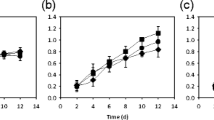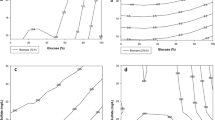Abstract
To investigate the effects of selenium and light wavelengths on the growth of liquid-cultured Cordyceps militaris and the main active components’ accumulation, culture conditions as selenium selenite concentrations and light of different wavelengths were studied. The results are: adenosine accumulation proved to be significantly selenium dependent (R 2 = 0.9403) and cordycepin contents were determined to be not significantly selenium dependent (R 2 = 0.3845) but significantly enhanced by selenium except for 20 ppm; there were significant differences in cordycepin contents, adenosine contents, and mycelium growth caused by light wavelengths: cordycepin, blue light > pink light > daylight, darkness, red light; adenosine, red light > pink light, darkness, daylight, blue light; and mycelium growth, red light > pink light, darkness, daylight > blue light. In conclusion, light wavelength had a significant influence on production of mycelia, adenosine, and cordycepin, so lightening wavelength should be changed according to target products in the liquid culture of C. militaris.



Similar content being viewed by others
References
Das, S. K., Masuda, M., Sakurai, A., & Sakakibara, M. (2010). Medicinal uses of the mushroom Cordyceps militaris: current state and prospects. Fitoterapia, 81, 961–968.
Khan, M. A., Tania, M., Zhang, D., & Chen, H. (2010). Cordyceps mushroom: a potent anticancer nutraceutical. The Open Nutraceuticals Journal, 8, 179–183.
Zhang, A., Lu, J., Zhang, N., Zheng, D., Zhang, G., & Teng, L. (2010). Extraction, purification and anti-tumor activity of polysaccharide from mycelium of mutant Cordyceps militaris. Chemical Research in Chinese Universities, 26, 798–802.
Chen, C., Luo, S. S., Li, Y., Sun, Y. J., & Zhang, C. K. (2004). Study on antioxidant activity of three Cordyceps sp. by chemiluminescence. Shanghai J Traditional Chinese Medicine, 38, 53–55. in Chinese.
Shih, I. L., Tsai, K. L., & Hsieh, C. (2007). Effects of culture conditions on the mycelial growth and bioactive metabolite production in submerged culture of Cordyceps militaris. Biochemical Engineering Journal, 33, 193–201.
Ahn, Y. J., Park, S. J., Lee, S. G., Shin, S. C., & Choi, D. H. (2000). Cordycepin: selective growth inhibitor derived from liquid culture of Cordycceps militaris against Clostridium spp. Journal of Agricultural and Food Chemistry, 48, 2744–2748.
Kodama, E. N., McCaffrey, R. P., Yusa, K., & Mitsuya, H. (2000). Antileukemic activity and mechanism of action of cordycepin against terminal deoxynucleotidyl transferase-positive (TdT+) leukemic cells. Biochemical Pharmacology, 59, 273–281.
Choi, S. B., Park, C. H., Choi, M. K., Jun, D. W., & Park, S. (2004). Improvement of insulin resistance and insulin secretion by water extracts of Cordyceps militaris, Phellinus linteus, and Paecilomyces tenuipes in 90% pancreatectomized rats. Bioscience, Biotechnology, and Biochemistry, 68, 2257–2264.
Jung, K., Kim, I. H., & Han, D. (2004). Effect of medicinal plant extracts on forced swimming capacity in mice. Journal of Ethnopharmacology, 93, 75–81.
Won, S. Y., & Park, E. H. (2005). Anti-inflammatory and related pharmacological activities of cultured mycelia and fruiting bodies of Cordyceps militaris. Journal of Ethnopharmacology, 96, 555–561.
The State Pharmacopoeia Commission of China (2005) Pharmacopoeia of China (pp. 75, vol I). Beijing: Chemical Industry Press.
Wong, Y. Y., Moon, A., Duffin, R., Barthet-Barateig, A., Meijer, H. A., Clemens, M. J., & Moor, C. H. (2010). Cordycepin inhibits protein synthesis and cell adhesion through effects on signal transduction. The Journal of Biological Chemistry, 285, 2610–2621.
Almagro F. L., Sabater-Jara, A. B., Belchí-Navarro, S., Fernández-Pérez, F., Bru, R., Pedreño, M. A. (2011). Effect of UV light on secondary metabolite biosynthesis in plant cell cultures elicited with cyclodextrins and methyl jasmonate. In: Plants and environment (pp.115-136). Charlotte: InTech
Lin, C. (2002). Blue light receptors and signal transduction. The Plant Cell, 14, 207–225.
Idnurm, A., Rodríguez-Romero, J., Corrochano, L. M., Sanz, C., Iturriaga, E. A., Eslava, A. P., & Heitman, J. (2006). The phycomyces madA gene encodes a blue-light photoreceptor for phototropism and other light responses. Proceedings of the National Academy of Sciences, 103, 4546–4551.
Cheng, P., Yang, Y., Wang, L., He, Q., & Liu, Y. (2002). WHITE COLLAR-1, a multifunctional Neurospora protein involved in the circadian feedback loops, light sensing, and transcription repression of wc-2. The Journal of Biological Chemistry, 278, 3801–3808.
Velayos, A., Blasco, J. L., Alvarez, M. I., & Iturriaga, E. A. (2000). Blue-light regulation of phytoene dehydrogenase (carB) gene expression in Mucor circinelloides. Planta, 210, 938–946.
Tara, F., Rayman, M. P., & Boskabadi, H. (2010). Prooxidant-antioxidant balance in pregnancy: a randomized double-blind placebo-controlled trial of selenium supplementation. Journal of Perinatal Medicine, 38, 473–478.
Ramoutar, R. R., & Brumaghim, J. L. (2010). Antioxidant and anticancer properties and mechanisms of inorganic selenium, oxo-sulfur, and oxo-selenium compounds. Cell Biochemistry and Biophysics, 58, 1–23.
Silva, I. C. M., Ribeiro, A. M. L., Canal, C. W., Trevizan, L., Macagnan, M., Gonçalves, T. A., Hlavac, N. R. C., de Almeida, L. L., & Pereira, R. A. (2010). The impact of organic and inorganic selenium on the immune system of growing broilers submitted to immune stimulation and heat stress. Brazilian Journal of Poultry Science, 4, 247–254.
Yu, R. M., Yang, W., Song, L. Y., Yan, C. Y., Zhang, Z., & Zhao, Y. (2007). Structural characterization and antioxidant activity of a polysaccharide from the fruiting bodies of cultured Cordycceps militaris. Carbohydrate Polymers, 70, 430–436.
Chun, J. Y., Nadiminty, N., Lee, S. O., Onate, S. A., Lou, W., & Gao, A. C. (2006). Mechanisms of selenium down-regulation of androgen receptor signaling in prostate cancer. Molecular Cancer Therapeutics, 5, 913–918.
Uden, P. C., Boakye, H. T., Kahakachchi, C., Hafezi, R., Nolibos, P., Block, E., Johnson, S., & Tyson, J. F. (2003). Element selective characterization of stability and reactivity of selenium species in selenized yeast. Journal of Analytical Atomic Spectrometry, 18, 1–10.
Dong, J. Z., Lei, C., Ai, X. R., & Wang, Y. (2012). Selenium enrichment on Cordyceps militaris Link and analysis on its main active components. Applied Biochemistry and Biotechnology, 166, 1215–1224.
Xing, L., Cohen, J. D., & Gardner, G. (2011). Low-fluence red light increases the transport and biosynthesis of auxin. Plant Physiology, 157, 891–904.
Denault, D. L. (2001). WC-2 mediates WC1-FRQ interaction within the PAS protein-linked circadian feedback loop of Neurospora. The EMBO Journal, 20, 109–117.
Smirnov, D.A., Shcherba, V.V., Bisko, N.A., Poyedinok, N.L. (2009). Some biologically active substances from a mycelial biomass of medicinal caterpillar fungus Cordyceps sinensis (Berk.) Sacc. (Ascomycetes). International Journal of Medicinal Mushrooms, 1, 69-76.
Poyedinok, N.L., Mykhailova, O.B., Shcherba, V.V., Buchalo, A.S., Negriyko, A.M. (2008). Light regulation of growth and biosynthetic activity of Ling Zhi or Reishi medicinal mushroom, Ganoderma lucidum (W. Curt.: Fr.) P. Karst. (Aphyllophoromycetideae), in pure culture. International Journal of Medicinal Mushrooms, 4, 369-378.
Puchkova, T. A., Babitskaya, V. G., Scherba, V., Bisko, N. A., & Poyedinok, N. L. (2010). Polysaccharides of medicinal caterpillar fungus, Cordyceps militaris Link (Ascomycetes): production and composition. International Journal of Medicinal Mushrooms, 4, 419–425.
Kredich, N. M., & Guarino, A. J. (1961). Studies on the biosynthesis of cordycepin. Biochimica et Biophysica Acta, 47, 529–534.
Ulusu, N. N., & Turan, B. (2005). Beneficial effects of selenium on some enzymes of diabetic rat heart. Biological Trace Element Research, 3, 207–215.
Acknowledgments
This research was partially funded by the Ethnological Affair Committee Foundation of China (Grant No. 10HB02) and by the Doctor Research Project (498012) of Hubei University for Nationalities. We are grateful to anonymous reviewers and scientific editor for the critical review and valuable suggestions.
Author information
Authors and Affiliations
Corresponding authors
Rights and permissions
About this article
Cite this article
Dong, J.Z., Liu, M.R., Lei, C. et al. Effects of Selenium and Light Wavelengths on Liquid Culture of Cordyceps militaris Link. Appl Biochem Biotechnol 166, 2030–2036 (2012). https://doi.org/10.1007/s12010-012-9628-5
Received:
Accepted:
Published:
Issue Date:
DOI: https://doi.org/10.1007/s12010-012-9628-5




